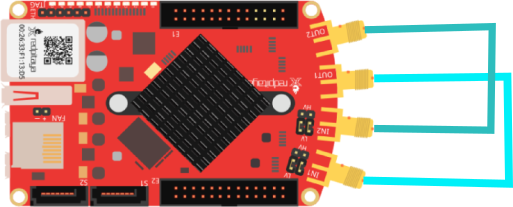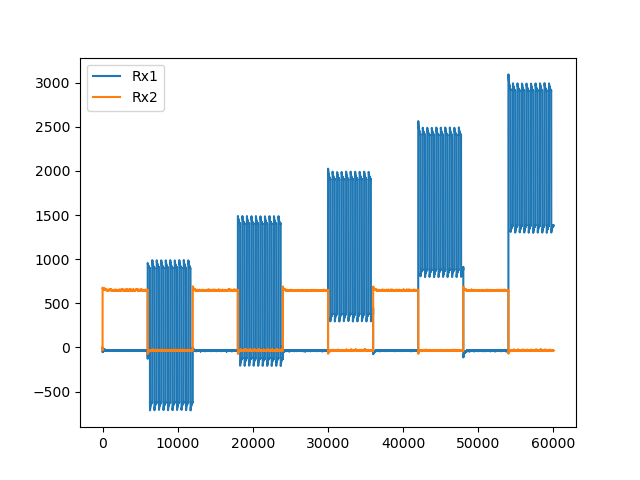Sequence Multi-Channel and Waveform Enable Example
This examples combines concepts from the three examples and additionally uses the signal enable feature of the sequences. This example uses both DAC and ADC channels of the RedPitaya. On the first DAC channel we output a sine waveform together with a climbing sequence. On the second channel we output just a sequence with a constant value and no waveforms at all. The signal enable flags of the sequences are set in such a way, that the two channels alternate being enabled with each step.

Julia Client
This and all other examples are located in the examples directory
using RedPitayaDAQServer
using CairoMakie
# obtain the URL of the RedPitaya
include("config.jl")
rp = RedPitaya(URLs[1])
serverMode!(rp, CONFIGURATION)
dec = 64
modulus = 12480
base_frequency = 125000000
periods_per_step = 5
samples_per_period = div(modulus, dec)
periods_per_frame = 50
frame_period = dec*samples_per_period*periods_per_frame / base_frequency
steps_per_frame = div(50, periods_per_step)
decimation!(rp, dec)
samplesPerPeriod!(rp, samples_per_period)
periodsPerFrame!(rp, periods_per_frame)
frequencyDAC!(rp,1,1, base_frequency / modulus)
signalTypeDAC!(rp, 1 , 1, "SINE")
amplitudeDAC!(rp, 1, 1, 0.2)
phaseDAC!(rp, 1, 1, 0.0 )
triggerMode!(rp, INTERNAL)
# Sequence Configuration
clearSequence!(rp)
stepsPerFrame!(rp, steps_per_frame)
seqChan!(rp, 1)
lut = collect(range(-0.5,0.5,length=steps_per_frame))
seq = SimpleSequence(lut, 2)
sequence!(rp, seq)
serverMode!(rp, ACQUISITION)
masterTrigger!(rp, true)
sleep(0.1)
samples_per_step = (samples_per_period * periods_per_frame)/steps_per_frame
timing = seqTiming(seq)
uCurrentFrame = readFrames(rp, div(timing.start*samples_per_step, samples_per_period * periods_per_frame), 2)
masterTrigger!(rp, false)
serverMode!(rp, CONFIGURATION)
plot = lines(vec(uCurrentFrame[:,1,:,:]), label = "Rx1")
lines!(plot.axis, vec(uCurrentFrame[:,2,:,:]), label = "Rx2")
axislegend(plot.axis)
save(joinpath(@__DIR__(), "images", "sequence.png"), plot)
plot